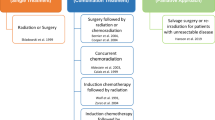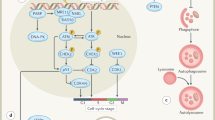Abstract
The epidermal growth factor receptor (EGFR) inhibitors are among the most intensely studied new molecular therapeutic agents. Although response rates have been somewhat disappointing when EGFR inhibitors are used as single-agent therapy for advanced disease, these inhibitors may be more effective as chemo- and radiosensitizers. The first phase III randomized trial evaluating EGFR inhibitors as radiosensitizers in patients with locally advanced head and neck cancer was strongly positive, indicating significant potential of this class of agents to improve outcome with radiotherapy. However, optimal implementation of EGFR inhibitors as radiosensitizers depends, in part, on a better understanding of the mechanisms of radiosensitization. Preclinical studies provide important observations with regard to potential mechanisms. The phenotypic cellular changes associated with EGFR inhibition are impressively consistent between different model systems, with almost all studies showing that EGFR inhibitors affect proliferation, angiogenesis, and cell survival. Whether EGFR inhibitors influence response to radiation directly, or whether the improved response is a result of additive effects of the two modalities, remains unclear. However, cell-cycle arrest, endothelial cell sensitivity, and apoptotic potential are all important factors in radiation response of epithelial tumors. Furthermore, less-studied effects of EGFR inhibitors on DNA repair suggest that modulation of DNA damage response to cytotoxic injury might result in radio- or chemosensitization. This review will explore potential mechanisms of radiosensitization by EGFR inhibitors.
This is a preview of subscription content, access via your institution
Access options
Subscribe to this journal
Receive 12 print issues and online access
$209.00 per year
only $17.42 per issue
Buy this article
- Purchase on Springer Link
- Instant access to full article PDF
Prices may be subject to local taxes which are calculated during checkout


Similar content being viewed by others
References
Arteaga CL (2001) The epidermal growth factor receptor: from mutant oncogene in nonhuman cancers to therapeutic target in human neoplasia. J Clin Oncol 19: 32S–40S
Mendelsohn J and Baselga J (2003) Status of epidermal growth factor receptor antagonists in the biology and treatment of cancer. J Clin Oncol 21: 2787–2799
Bonner J et al. (2004) Cetuximab prolongs survival in patients with locoregionally advanced squamous cell carcinoma of head and neck: a phase III study of high dose radiation therapy with or without cetuximab [abstract]. J Clin Oncol 22: a5507
Miyaguchi M et al. (1998) Correlation of epidermal growth factor receptor and radiosensitivity in human maxillary carcinoma cell lines. Acta Otolaryngol (Stockh) 118: 428–431
Sheridan MT et al. (1997) Potential indicators of radiosensitivity in squamous cell carcinoma of the head and neck. Radiat Oncol Investig 5: 180–186
Akimoto T et al. (1999) Inverse relationship between epidermal growth factor receptor expression and radiocurability of murine carcinomas. Clin Cancer Res 5: 2884–2890
Milas L et al. (2004) Epidermal growth factor receptor and tumor response to radiation: in vivo preclinical studies. Int J Radiation Oncology Biol Phys 58: 966–971
Harari PM and Huang SM (2001) Head and neck cancer as a clinical model for molecular targeting of therapy: combining EGFR blockade with radiation. Int J Radiat Oncol Biol Phys 49: 427–433
Milas L et al. (2000) In vivo enhancement of tumor radioresponse by C225 antiepidermal growth factor receptor antibody. Clin Cancer Res 6: 701–708
Bonner JA et al. (2000) Enhanced apoptosis with combination C225/radiation treatment serves as the impetus for clinical investigation in head and neck cancers. J Clin Oncol 18: 47S–53S
Huang SM et al. (1999) Epidermal growth factor receptor blockade with C225 modulates proliferation, apoptosis, and radiosensitivity in squamous cell carcinomas of the head and neck. Cancer Res 59: 1935–1940
Nasu S et al. (2001) C225 antiepidermal growth factor receptor antibody enhances tumor radiocurability. Int J Radiat Oncol Biol Phys 51: 474–477
Huang SM et al. (2002) Modulation of radiation response and tumor-induced angiogenesis after epidermal growth factor receptor inhibition by ZD1839 (Iressa). Cancer Res 62: 4300–4306
Shintani S et al. (2003) Enhancement of tumor radioresponse by combined treatment with gefitinib (Iressa, ZD1839), an epidermal growth factor receptor tyrosine kinase inhibitor, is accompanied by inhibition of DNA damage repair and cell growth in oral cancer. Int J Cancer 107: 1030–1037
Robert F et al. (2001) Phase I study of anti-epidermal growth factor receptor antibody cetuximab in combination with radiation therapy in patients with advanced head and neck cancer. J Clin Oncol 19: 3234–3243
Bonner J et al. (2000) Continued response following treatment with IMC-C225, an EGFr MoAb, combined with RT in advanced head and neck malignancies [abstract]. In American Society of Clinical Oncology 36th Annual Meeting; 2000 May 20–23; New Orleans, LA
Withers HR et al. (1988) The hazard of accelerated tumor clonogen repopulation during radiotherapy. Acta Oncol 27: 131–146
Dorr W (1997) Three A's of repopulation during fractionated irradiation of squamous epithelia: asymmetry loss, acceleration of stem-cell divisions and abortive divisions. Int J Radiat Biol 72: 635–643
Schmidt-Ullrich RK et al. (1997) Radiation-induced proliferation of the human A431 squamous carcinoma cells is dependent on EGFR tyrosine phosphorylation. Oncogene 15: 1191–1197
Dent P et al. (1999) Radiation-induced release of transforming growth factor alpha activates the epidermal growth factor receptor and mitogen-activated protein kinase pathway in carcinoma cells, leading to increased proliferation and protection from radiation-induced cell death. Mol Biol Cell 10: 2493–2506
Milas L et al. (2002) Role of Epidermal Growth Factor Receptor (EGFR) and its Inhibition in Radiotherapy. (Eds Nieder C et al.) Heidelberg: Springer
Eriksen JG et al. (2004) The prognostic value of epidermal growth factor receptor is related to tumor differentiation and the overall treatment time of radiotherapy in squamous cell carcinomas of the head and neck. Int J Radiat Oncol Biol Phys 58: 561–566
Mendelsohn J (1997) Epidermal growth factor receptor inhibition by a monoclonal antibody as anticancer therapy. Clin Cancer Res 3: 2703–2707
Rusnak DW et al. (2001) The effects of the novel, reversible epidermal growth factor receptor/ErbB-2 tyrosine kinase inhibitor, GW2016, on the growth of human normal and tumor-derived cell lines in vitro and in vivo. Mol Cancer Ther 1: 85–94
Crombet-Ramos T et al. (2002) Antiproliferative, antiangiogenic and proapoptotic activity of h-R3: A humanized anti-EGFR antibody. Int J Cancer 101: 567–575
Nyati MK et al. (2004) Radiosensitization by pan ErbB inhibitor CI-1033 in vitro and in vivo. Clin Cancer Res 10: 691–700
Raben D et al. (2001) in Molecular Targets and Cancer Therapeutics: Discovery, Biology, and Clinical Applications [abstract A756] Clin Cancer Res
Solomon B et al. (2003) EGFR blockade with ZD1839 (“Iressa”) potentiates the antitumor effects of single and multiple fractions of ionizing radiation in human A431 squamous cell carcinoma. Epidermal growth factor receptor. Int J Radiat Oncol Biol Phys 55: 713–723
Buchsbaum DJ et al. (2002) Treatment of pancreatic cancer xenografts with Erbitux (IMC-C225) anti-EGFR antibody, gemcitabine, and radiation. Int J Radiat Oncol Biol Phys 54: 1180–1193
Albanell J et al. (2002) Pharmacodynamic studies of the epidermal growth factor receptor inhibitor ZD1839 in skin from cancer patients: histopathologic and molecular consequences of receptor inhibition. J Clin Oncol 20: 110–124
Iliakis G et al. (2003) DNA damage checkpoint control in cells exposed to ionizing radiation. Oncogene 22: 5834–5847
Raben D et al. (2002) ZD1839, a selective epidermal growth factor receptor tyrosine kinase inhibitor, alone and in combination with radiation and chemotherapy as a new therapeutic strategy in non-small cell lung cancer. Semin Oncol 29: 37–46
Balaban N et al. (1996) The effect of ionizing radiation on signal transduction: antibodies to EGF receptor sensitize A431 cells to radiation. Biochim Biophys Acta 1314: 147–156
Bianco C et al. (2002) Enhancement of antitumor activity of ionizing radiation by combined treatment with the selective epidermal growth factor receptor-tyrosine kinase inhibitor ZD1839 (Iressa). Clin Cancer Res 8: 3250–3258
Murakami M et al. (2004) Induction of apoptosis by ionizing radiation and CI-1033 in HuCCT-1 cells. Biochem Biophys Res Commun 319: 114–119
Garcia-Barros M et al. (2003) Tumor response to radiotherapy regulated by endothelial cell apoptosis. Science 300: 1155–1159
Gorski DH et al. (1999) Blockage of the vascular endothelial growth factor stress response increases the antitumor effects of ionizing radiation. Cancer Res 59: 3374–3378
Goldman CK et al. (1993) Epidermal growth factor stimulates vascular endothelial growth factor production by human malignant glioma cells: a model of glioblastoma multiforme pathophysiology. Mol Biol Cell 4: 121–133
Huang SM and Harari PM (2000) Modulation of radiation response after epidermal growth factor receptor blockade in squamous cell carcinomas: inhibition of damage repair, cell cycle kinetics, and tumor angiogenesis. Clin Cancer Res 6: 2166–2174
Hirata A et al. (2002) ZD1839 (Iressa) induces antiangiogenic effects through inhibition of epidermal growth factor receptor tyrosine kinase. Cancer Res 62: 2554–2560
Viloria-Petit A et al. (2001) Acquired resistance to the antitumor effect of epidermal growth factor receptor-blocking antibodies in vivo: a role for altered tumor angiogenesis. Cancer Research 61: 5090–5101
Hirata A et al. (2004) Direct inhibition of EGF receptor activation in vascular endothelial cells by gefitinib ('Iressa', ZD1839). Cancer Sci 95: 614–618
Khanna KK and Jackson SP (2001) DNA double-strand breaks: signaling, repair and the cancer connection. Nat Genet 27: 247–254
Lieber MR et al. (1997) Tying loose ends: roles of Ku and DNA-dependent protein kinase in the repair of double-strand breaks. Curr Opin Genet Dev 7: 99–104
Bandyopadhyay D et al. (1998) Physical interaction between epidermal growth factor receptor and DNA-dependent protein kinase in mammalian cells. J Biol Chem 273: 1568–1573
Olayioye MA et al. (2000) The ErbB signaling network: receptor heterodimerization in development and cancer. EMBO J 19: 3159–3167
Dent P et al. (2003) MAPK pathways in radiation responses. Oncogene 22: 5885–5896
Pirollo KF et al. (1997) Evidence supporting a signal transduction pathway leading to the radiation-resistant phenotype in human tumor cells. Biochem Biophys Res Commun 230: 196–201
Zhou H et al. (2004) Effects of the EGFR/HER2 kinase inhibitor GW572016 on EGFR- and HER2-overexpressing breast cancer cell line proliferation, radiosensitization, and resistance. Int J Radiat Oncol Biol Phys 58: 344–352
Brognard J et al. (2001) Akt/protein kinase B is constitutively active in non-small cell lung cancer cells and promotes cellular survival and resistance to chemotherapy and radiation. Cancer Res 61: 3986–3997
Gupta AK et al. (2002) Local recurrence in head and neck cancer: relationship to radiation resistance and signal transduction. Clin Cancer Res 8: 885–892
Grana TM et al. (2002) Ras mediates radioresistance through both phosphatidylinositol 3-kinase- dependent and Raf-dependent but mitogen-activated protein kinase/extracellular signal-regulated kinase kinase-independent signaling pathways. Cancer Res 62: 4142–4150
Grana TM et al. (2003) Epidermal growth factor receptor autocrine signaling in RIE-1 cells transformed by the Ras oncogene enhances radiation resistance. Cancer Res 63: 7807–7814
Sarkaria JN et al. (1998) Inhibition of phosphoinositide 3-kinase related kinases by the radiosensitizing agent wortmannin. Cancer Res 58: 4375–4382
Acknowledgements
We acknowledge those whose work was not directly referenced due to space constraints. This work was supported in part by NIH/NCI K08-CA83753, and UNC Breast Cancer Specialized Program of Research Excellence (SPORE) award from the National Cancer Institute (CA58223).
Author information
Authors and Affiliations
Corresponding author
Ethics declarations
Competing interests
The author declared that she receives clinical trial research support from both Genentech, Inc and GlaxoSmithKline.
Rights and permissions
About this article
Cite this article
Sartor, C. Mechanisms of Disease: radiosensitization by epidermal growth factor receptor inhibitors. Nat Rev Clin Oncol 1, 80–87 (2004). https://doi.org/10.1038/ncponc0048
Received:
Accepted:
Issue Date:
DOI: https://doi.org/10.1038/ncponc0048
This article is cited by
-
Phase I trial of dacomitinib, a pan-human epidermal growth factor receptor (HER) inhibitor, with concurrent radiotherapy and cisplatin in patients with locoregionally advanced squamous cell carcinoma of the head and neck (XDC-001)
Investigational New Drugs (2016)
-
A comprehensive analysis of radiosensitization targets; functional inhibition of DNA methyltransferase 3B radiosensitizes by disrupting DNA damage regulation
Scientific Reports (2015)
-
A phase I study of lapatinib with whole brain radiotherapy in patients with Human Epidermal Growth Factor Receptor 2 (HER2)-positive breast cancer brain metastases
Breast Cancer Research and Treatment (2013)
-
Management of EGFR-inhibitor associated rash: a retrospective study in 49 patients
European Journal of Medical Research (2012)
-
Neoadjuvant chemoradiation therapy for the treatment of esophageal carcinoma
International Journal of Clinical Oncology (2008)



